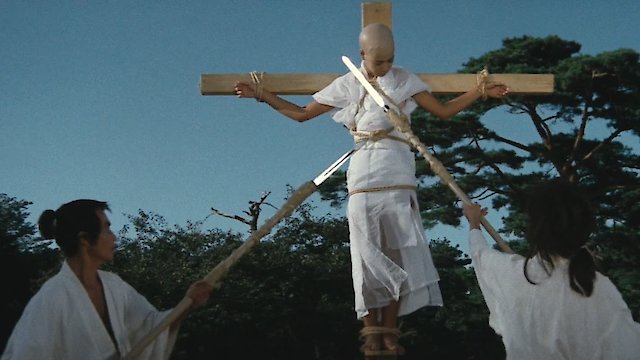
Shogun's Joys of Torture
Where to Watch Shogun's Joys of Torture

Shogun's Joys of Torture is a Japanese exploitation film released in 1968, directed by Teruo Ishii. The film is renowned for being a part of the ero guro (erotic-grotesque) subgenre, a cultural movement in Japan that focuses on themes of eroticism, sexual corruption, and decadence, often intersecting with elements of horror or the macabre. Known in Japan as "Tokugawa Onna Keibatsu-shi," which translates to "The Tokugawa Woman's Punishment Chronicles," the film provides a cinematic reflection of this controversial and provocative genre.
The film stars Teruo Yoshida, Masumi Tachibana, and Fumio Watanabe in pivotal roles, and is part of the larger "Tokugawa" film series, known for its sensationalistic portrayal of torture and sadism during the Edo period of Japan, under the rule of the Tokugawa shogunate. Though it is a product of its time, it's important to understand the context within which it was created to avoid misinterpreting its graphic and unsettling content.
Shogun's Joys of Torture unfolds as an anthology, consisting of several vignettes that explore the rampant cruelty and inhuman forms of punishment meted out to criminals and perceived enemies of the state, as well as unfortunate individuals caught in the machinations of power, class, and morality under the shogunate's iron rule. The film doesn't shy away from showcasing extreme depictions of suffering and oppression, especially towards women, whom the narratives often center around.
The visual style of the movie is stark and sometimes surreal, with the director Ishii utilizing atmospheric lighting, color, and set design to emphasize the grotesque and chilling nature of the stories being told. The production often sways between the boundaries of arthouse and grindhouse aesthetics, crafting a filmic experience that is both visually arresting and profoundly unsettling.
Each segment in the movie explores different aspects of the era's punitive practices and the accompanying socio-political implications. The episodic structure allows the director to delve into various levels of society, from the upper echelons who perpetrate and profit from the horrors, to the lower classes, who are most often the victims. The film, though fictional, is purportedly based on historical punishments and the consequent suffering that was part of the penal system in feudal Japan.
One of the most striking features of Shogun's Joys of Torture is its unflinching examination of the social dynamics within the Tokugawa period. The film highlights the severe moral codes, the weight of sin and guilt, and the double standards applied to men and women of the time. The rigid caste system and the consequential lack of autonomy for individuals, particularly for women, are recurring themes in each tale, painting a vivid portrait of a society deeply enmeshed in rituals of power and subjugation.
Throughout the film, the performances of the main cast, including Yoshida, Tachibana, and Watanabe, are intense and driven, adding a layer of grave sincerity to the stories being depicted. Their characters often find themselves entangled in complex conspiracies and tragic circumstances that symbolize the broader historical and cultural forces at play during this dark chapter in Japanese history.
The score of Shogun's Joys of Torture adds another dimension to the film, blending traditional Japanese music with more avant-garde and dramatic compositions. This sonic landscape reinforces the emotional and thematic weight of the film's narrative arcs, further immersing the audience in the historical atmosphere of the time.
As a cultural artifact of the late 1960s, the film can also be seen as a commentary on contemporary issues of the time. Japan was experiencing rapid modernization and societal change, which often came with a re-evaluation and critique of its past. In this light, the film acts as a form of extreme artistic expression, questioning the foundations of authority, morality, and human cruelty inherent within Japan's history.
Shogun's Joys of Torture is certainly not a film for the faint of heart. It is graphic, explicit, and often disturbing in its content and imagery. As with many films within the exploitation genre, it is designed to provoke a strong reaction and prompt discussion about the nature of human suffering and the social frameworks that enable such atrocities. The film is likely to appeal to a niche audience, particularly those with an interest in Japanese cinema, the ero guro movement, and historical accounts of punishment and torture. Viewers should approach this film with an awareness of its explicit content and a readiness to confront the darker aspects of human history and psychology it reveals.
Shogun's Joys of Torture is a Horror, Drama movie released in 1968. It has a runtime of 85 min. Critics and viewers have rated it moderate reviews, with an IMDb score of 6.1..
How to Watch Shogun's Joys of Torture
Where can I stream Shogun's Joys of Torture movie online? Shogun's Joys of Torture is available to watch and stream, buy on demand, download at Prime Video, Apple TV Store, Amazon. Some platforms allow you to rent Shogun's Joys of Torture for a limited time or purchase the movie for downloading.
